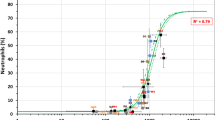Abstract
Risk evaluations for nanomaterials require the generation of hazard data as well as exposure assessments. Most of the validated nanotoxicity studies have been conducted using in vivo experimental designs. It would be highly desirable to develop in vitro pulmonary hazard tests to assess the toxicity of fine and nanoscale particle-types. However, in vitro evaluations for pulmonary hazards are known to have limited predictive value for identifying in vivo lung toxicity effects. Accordingly, this study investigated the capacity of in vitro screening studies to predict in vivo pulmonary toxicity of several fine or nanoparticle-types following exposures in rats. Initially, complete physicochemical characterization of particulates was conducted, both in the dry and wet states. Second, rats were exposed by intratracheal instillation to 1 or 5 mg/kg of the following particle-types: carbonyl iron, crystalline silica, amorphous silica, nanoscale zinc oxide, or fine zinc oxide. Inflammation and cytotoxicity endpoints were measured at 24 h, 1 week, 1 month and 3 months post-instillation exposure. In addition, histopathological analyses of lung tissues were conducted at 3 months post-exposure. Pulmonary cell in vitro studies consisted of three different culture conditions at 4 different time periods. These included (1) rat L2 lung epithelial cells, (2) primary rat alveolar macrophages, and (3) alveolar macrophage—L2 lung epithelial cell co-cultures which were incubated with the same particles as tested in the in vivo study for 1, 4, 24, or 48 h. Cell culture fluids were evaluated for cytotoxicity endpoints and inflammatory cytokines at the different time periods in an attempt to match the biomarkers assessed in the in vivo study. Results of in vivo pulmonary toxicity studies demonstrated that instilled carbonyl iron particles produced little toxicity. Crystalline silica and amorphous silica particle exposures produced substantial inflammatory and cytotoxic effects initially, but only the crystalline silica variety produced sustained and progressive inflammatory and cytotoxic responses, leading to the development of pulmonary fibrosis. Exposures to nanoscale or fine-sized zinc oxide particles produced potent but typical “metal fume fever”-like reversible inflammation/cytotoxic effects which were resolved by 1-month postinstillation exposure. In contrast to the in vivo results, using cytotoxicity and inflammation endpoints, in vitro effects to the various particle-types were difficult to gauge, owing to the number of variables that were studied (i.e., cell-types, time-course, dose response (including particle overload doses)), and various endpoints (e.g., cytotoxicity = LDH, MTT; inflammation/cytokines = MIP-2). For instance, none of the in vitro endpoints could mimic a transient inflammatory/cytotoxic response—as was measured following exposures to amorphous silica, or fine or nanoscale zinc oxide particles. We conclude that current in vitro cell culture systems do not accurately forecast the pulmonary hazard responses of instilled particle-types. It seems clear that in vitro cellular systems will need to be further developed, standardized, and validated (relative to in vivo effects) in order to provide useful screening data on the relative toxicity of inhaled particles.





Similar content being viewed by others
References
Argilés JM, Lopez-Soriano J, Busquets S, Lopez-Soriano FJ (1997) Journey from cachexia to obesity by TNF. FASEB J 11:743–751
Brody AR, Roe MW (1983) Deposition pattern of inorganic particles at the alveolar level in the lungs of rats and mice. Am Rev Respir Dis 128:724–729
Faux SP, Tran CL, Miller BG, Jones AD, Monteiller C, Donaldson K (2003) Research report 154. Prepared by Institute of Occupational Medicine for the Health and Safety Executive
Maynard AD, Aitken RJ, Butz T, Colvin V, Donaldson K, Oberdörster G et al (2006) Safe handling of nanotechnology. Nature 444:267–269. doi:10.1038/444267a
Seagrave JC, McDonald JD, Mauderly JL (2005) In vitro versus in vivo exposure to combustion emissions. Exp Toxicol Pathol 57:233–238. doi:10.1016/j.etp.2005.05.011
Sherry B, Horii Y, Manogue KR, Widmer U, Cerami A (1992) In: Baggiolini M, Sorg C (eds) Interleukin-8 (NAP-1) and related chemotactic cytokines, vol 4. Karger, Basel, pp 117–130
Warheit DB, Hartsky MA (1990) Species comparisons of proximal alveolar deposition patterns of inhaled particulates. Exp Lung Res 16:83–99. doi:10.3109/01902149009087874
Warheit DB, Overby LH, George G, Brody AR (1988) Pulmonary macrophages are attracted to inhaled particles through complement activation. Exp Lung Res 4:51–66. doi:10.3109/01902148809062850
Warheit DB, Carakostas MC, Hartsky MA, Hansen JF (1991) Development of a short-term inhalation bioassay to assess pulmonary toxicity of inhaled particles: comparisons of pulmonary responses to carbonyl iron and silica. Toxicol Appl Pharmacol 107:350–368. doi:10.1016/0041-008X(91)90215-Z
Warheit DB, Webb TR, Sayes CM, Colvin VL, Reed KL (2006) Pulmonary bioassay studies with nanoscale and fine-quartz particles in rats: toxicity is not dependent upon particle size but on surface characteristics. Toxicol Sci 91:227–236. doi:10.1093/toxsci/kfj140
Widmer U, Manogue KR, Cerami A, Sherry B (1993) Genomic cloning and promoter analysis of macrophage inflammatory protein (MIP)-2, MIP-1 alpha, and MIP-1 beta, members of the chemokine superfamily of proinflammatory cytokines. J Immunol 150:4996–5012
Wolpe SD, Sherry B, Juers D, Davatelis G, Yurt RW, Cerami A (1989) Identification and characterization of macrophage inflammatory protein 2. Proc Natl Acad Sci USA 86:612–616. doi:10.1073/pnas.86.2.612
Author information
Authors and Affiliations
Corresponding author
Rights and permissions
About this article
Cite this article
Sayes, C.M., Reed, K.L., Subramoney, S. et al. Can in vitro assays substitute for in vivo studies in assessing the pulmonary hazards of fine and nanoscale materials?. J Nanopart Res 11, 421–431 (2009). https://doi.org/10.1007/s11051-008-9471-3
Received:
Accepted:
Published:
Issue Date:
DOI: https://doi.org/10.1007/s11051-008-9471-3




